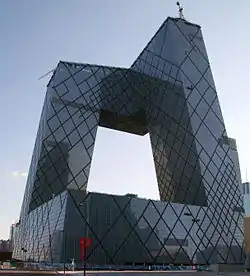Hujialou Subdistrict
呼家楼街道 | |
|---|---|
 China Central Television Headquarter within the subdistrict, 2013 | |
 Hujialou Subdistrict  Hujialou Subdistrict | |
| Coordinates: 39°55′11″N 116°27′29″E / 39.91972°N 116.45806°E | |
| Country | China |
| Municipality | Beijing |
| District | Chaoyang |
| Area | |
| • Total | 2.8 km2 (1.1 sq mi) |
| Population (2020) | |
| • Total | 53,018 |
| • Density | 19,000/km2 (49,000/sq mi) |
| Time zone | UTC+8 (China Standard) |
| Postal code | 100026 |
| Area code | 010 |
Hujialou Subdistrict (Chinese: 呼家楼街道; pinyin: Hūjiālóu Jiēdào) is a subdistrict of Chaoyang District, Beijing, China. It is located south of Sanlitun and Tuanjiehu Subdistricts, west of Balizhuang Subdistrict, north of Jianwai Subdistrict, and east of Chaowai Subdistrict. The 2020 population of the subdistrict was 50,318.[1]
Name
This area used to be called Huanggufen (Chinese: 皇姑坟; lit. 'tomb of royal aunt'), as for which royalty was buried here is unknown. Around the end of Qing dynasty, A family with the surname Hu constructed a prominent building that can be seen from afar, and as time went on, Hujialou (Chinese: 呼家楼; lit. 'Building of Hu family') became the name of this area.[2]
History
| Year | Change |
|---|---|
| 1956 | Xiaozhuang Subdistrict was established as part of East Suburban District |
| 1959 | Balizhuang Subdistrict was incorporated into Xiaozhuang |
| 1960 | Reorganized into a commune. Balizhuang Subdistrict was separated out and made into its own commune |
| 1966 | People's Commune of Xiaozhuang changed to People's Commune of Hujialou |
| 1968 | People's Commune of Hujialou was changed to Dazhailu Subdistrict |
| 1975 | Dazhailu Subdistrict was renamed Hujialou Subdistrict |
Administrative Division
As of 2021, there are a total of 11 communities within the subdistrict:[4]
| Administrative Division Code | Community Name in English | Community Name in Simplified Chinese |
|---|---|---|
| 110105003041 | Jintaili | 金台里 |
| 110105003042 | Xiaozhuang | 小庄 |
| 110105003045 | Guandongdian | 关东店北街 |
| 110105003046 | Hetaoyuan | 核桃园 |
| 110105003047 | Hujialoubei | 呼家楼北 |
| 110105003048 | Hujialounan | 呼家楼南 |
| 110105003049 | Jintai | 金台 |
| 110105003050 | Dongdaqiao | 东大桥 |
| 110105003051 | Guandongdian | 关东店 |
| 110105003052 | Xinjie | 新街 |
| 110105003053 | Jintong | 金桐 |
References
- ↑ Zhong guo tong ji nian jian = China statistical yearbook. 2020(zong di 39 qi) 2020(No. 39). Guo jia tong ji ju, 国家统计局. (Di 1 ban ed.). Beijing: Zhong guo tong ji chu ban she. 2020. ISBN 978-7-5037-9225-0. OCLC 1262741013.
{{cite book}}: CS1 maint: others (link) - ↑ Hu,Liping; 户力平 (2020). Bei jing di tie zhan ming zhang gu = Allusions in the subway stations' name of Beijing (Di 1 ban ed.). Beijing: Dong fang chu ban she. ISBN 978-7-5207-1180-7. OCLC 1243234501.
- ↑ Zhong hua ren min gong he guo zheng qu da dian. Bei jing shi juan. Li li guo, Li wan jun, Wu shi min, 李立国., 李万钧., 吴世民. Bei jing: Zhong guo she hui chu ban she. 2013. ISBN 978-7-5087-4058-4. OCLC 910451741.
{{cite book}}: CS1 maint: others (link) - ↑ "2021年统计用区划代码和城乡划分代码". www.stats.gov.cn. Retrieved 2022-09-22.